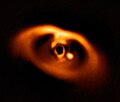External links
- Target Selection for SETI: 1. A Catalog of Nearby Habitable Stellar Systems, Turnbull, Tarter, submitted 31 Oct 2002 (last accessed 19 Jan 2010)
- Target selection for SETI. II. Tycho-2 dwarfs, old open clusters, and the nearest 100 stars Archived 2008-08-21 at the Wayback Machine , by Turnbull and Tarter, (last accessed 19 Jan 2010)
- HabStars Archived 2003-10-04 at the Wayback Machine - an article on the NASA website
Exoplanets | |||||||
|---|---|---|---|---|---|---|---|
| Main topics | |||||||
| Sizes and types |
| ||||||
| Formation and evolution |
| ||||||
| Systems | |||||||
| Host stars | |||||||
| Detection | |||||||
| Habitability |
| ||||||
| Catalogues | |||||||
| Lists |
| ||||||
| Other |
| ||||||
| | This astrobiology-related article is a stub. You can help Wikipedia by expanding it. |
| | This astronomical catalog article is a stub. You can help Wikipedia by expanding it. |
